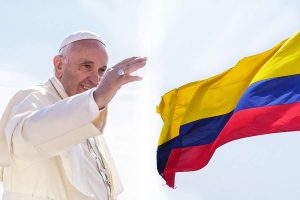
via CatholicNewsAgency.com
Pope Francis recently finished up a six-day tour of Colombia, in which he visited multiple religious sites to give sermons and meet with Catholics. The last visit made by a pope was in 1986 by Pope John Paul II under tumultuous circumstances; at the time, conflict between the Colombian government and the Revolutionary Armed Forces of Columbia (FARC) was raging and limited the Pope’s access to the Colombian people. While Pope Francis was not restricted by the tensions between FARC and the Colombian government, the conflict informed much of his trip through the country. Recently the Colombian government held a referendum on whether or not FARC rebels should be allowed to return to civilian life if they renounce their allegiance to the domestic terrorist organization. The referendum failed among the Colombian people, but the Colombian Congress approved the measure. With this, 7,000 former rebels have agreed to lay down their arms and cease fighting to return to normal civilian life. In addition to this, FARC is forming a legitimate political party in order to properly engage with the country’s political process.
To many Colombians, this is not a positive development; FARC’s guerilla actions and conflict with the government over the past 52 years have resulted in an estimated 220,000 deaths and six million displaced individuals. Clearly, many citizens have been impacted by this conflicted, and are clamoring that the former rebels receive some sort of state-sanctioned punishment. In light of this development, Pope Francis has been arguing that the people of Colombia must find it in their hearts to forgive the rebels and embrace a path towards peace at any cost. Prior to his visit, he addressed the Colombian people with a video and declared that “Let us take the first step” towards peace was the overarching message of his travels.
Obviously, this is not a universally welcomed message, and there are multiple other circumstances that are complicating the situation. While the Vatican is vehemently pushing for the adoption of a “peace at any cost” policy for its followers and the Colombian people, Evangelist churches based in Colombia believe that it goes against religious values held by Christians to allow these deeds to go unpunished. Even further, the Vatican being so closely aligned with the government may prove to be disastrous. While FARC has already held up their end of the arrangement, the government has failed to follow through on multiple aspects of the agreement, including providing areas formerly controlled by FARC with access to clean, running water. The future of the situation is uncertain, but could have large implications for the Catholic Church’s presence and influence in Colombia.
The article focuses mostly on the happenings of the Colombian government and the Vatican, which limits an opportunity to look at how the average Colombian citizen is represented within the media. A few quotes from citizens are given, but their individual stories are marginalized in the context of the story, which I find perplexing given the amount of space the article gives the importance of public opinion. The Colombian government itself is portrayed in a fairly neutral tone. The author mentions that the government had been working on a peace agreement for some time, but also that they had not followed through on several promises and that the actual implementation of the peace agreements “could present the greatest challenges this year”, which felt like a slight indictment of the Colombian government.
I found this article important to consider in the context of our class due to the fact that we will be looking at the role that the Catholic Church plays throughout the South American continent. Throughout Europe’s history of colonialism, the Catholic Church was a vehicle of oppression and justification for imperial expansion. We have already seen this in several readings’ allusions to the importance of reading the Bible and spreading the values of Christianity, but as power over the continent becomes more solidified, the role of the Church becomes prominent. This history is important to acknowledge when looking at contemporary events such as the ones described within the article.
In addition to the New York Times article on this subject, the news network teleSUR has a wonderful interactive webpage detailing the Vatican’s relationship with Latin American states over the course of the 20th and 21st century in light of this visit.
Original News Article:
